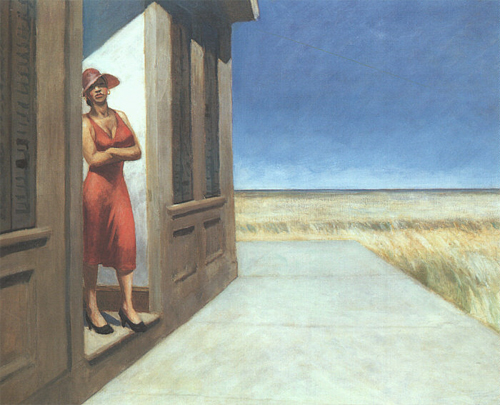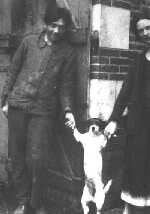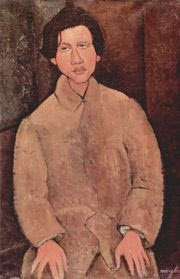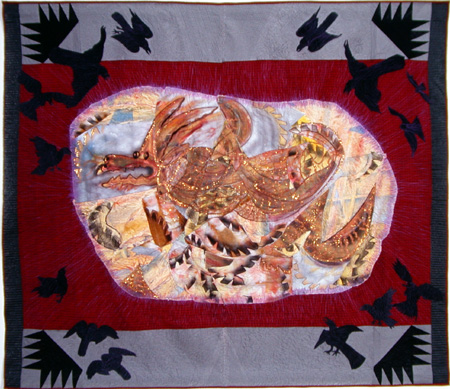Posted by Birgit Zipser on June 3rd, 2011
Paintings depicting 3-dimensional and arial views were abundant in an exhibition of current Chinese art at NAMOC, the National Museum of Chinese Art, in Beijing in March 2011.

Cheng, Wen-ji, Embracing, 114.5 cm x 200 cm, oil on canvas, 2009
This bowl, seen from a distance across the room, looked startingly 3-D. We stepped close to admire its geometric perfection. more… »
Posted by Birgit Zipser on February 18th, 2011
The two paintings of Edward Hopper, shown here, are part of the current exhibition in the Whitney Museum of American Art: Edward Hopper and His Time. Much has been written about Hopper’s usage of light and shadow. I will point out his usage of incongruencies that further accentuates the sense of isolation and alienation that Hopper’s painting are known for.
 more… »
more… »
Posted by Tree Smith on January 24th, 2010

Soutine with Dog
In Part 1 of this series, I wrote about how Soutine’s use of Christian imagery mixed with his life experiences, artistic influences and his own Jewish culture in his paintins, particularly his carcass paintings such as Flayed Rabbit from 1924. In Part 2, I uncovered beliefs and superstitions specific to the area where Soutine was raised, and how I believe they influenced his work, particularly the idea of the Angel Dumah and his fascination with death. Part 3 goes deeper into these ideas and how one painting in particular encapsulates them.
more… »
Posted by Tree Smith on January 9th, 2010

19th century shtetl
In the book, Journey to a Nineteenth-Century Shtetl, Yekhezkel Kotik shares his memories of living in a shtetl not far from Soutine’s home of Smilovitchi in what is now Lithuania and what was once the part of Tsarist Russia that held on desperately to the edge of its borders with dirty fingernails. Of the superstitious beliefs of the townspeople, and there were many, there is this one in regard to death,
more… »
Posted by Tree Smith on December 31st, 2009

Modigliani, Portrait of Soutine
The artist Chaim Soutine’s still life paintings of animals, what I prefer to call his carcass paintings, can be unsettling, especially given the fact that Soutine was known to have never worked from memory, but rather used live, or dead, models for all his works.
Nearly all of Soutine’s art can be jarring to the viewer for a variety of reasons; his use of color, his lines, his brushstrokes and overall style as well as his subject matter are startling, but after our initial response what are we to make of these works? And what is it that Soutine was trying to say?
more… »
Posted by June Underwood on November 1st, 2009
Posted by June Underwood on October 16th, 2009
The phrase, “Sloppy Craft”, the title of a recent panel discussion and a forthcoming exhibition at Portland’s Contemporary Crafts Museum, had to be checked out. Whatever could it mean? How could the Contemporary Crafts Museum have been drawn into featuring sloppiness? What kind of provocation was intended by the title? What are the implications of honoring such a concept as sloppy craft for art as well as craft? Tell me more, tell me more.
A bit of background: when I was working textiles, I regularly engaged in a “discussion” with quilters (some traditional, some contemporary) about whether the stitching work done on my textiles ( specifically in construction and quilting) should strive for perfection. I always maintained that my goal was “competence.” My attention was entirely on the image and impact (on, I maintained, the art). The craft was there only to hold it together and/or to add to the art. Hence my seams were not necessarily straight and the back of the art was decent but not flawless (I didn’t bury my threads, for example, simply tidied them). I used the quilting stitches as part of the design, which meant that they were generally not even in length and that they were heavy in places and light in others; this can make the quilted art hang wonkily, requiring heroic measures to make it perform well.
This is an example of a old piece of mine that I claim has “competent” craft:
 Sophie, Emerging, 84 x 73″, 2002, Materials: hand-painted cotton, canvas, silk, stretch-polyester, felt. Methods: hand- painted-and-dyed, airbrushed and commercial fabrics. Machine stitched.
Sophie, Emerging, 84 x 73″, 2002, Materials: hand-painted cotton, canvas, silk, stretch-polyester, felt. Methods: hand- painted-and-dyed, airbrushed and commercial fabrics. Machine stitched.
more… »






 Sophie, Emerging, 84 x 73″, 2002, Materials: hand-painted cotton, canvas, silk, stretch-polyester, felt. Methods: hand- painted-and-dyed, airbrushed and commercial fabrics. Machine stitched.
Sophie, Emerging, 84 x 73″, 2002, Materials: hand-painted cotton, canvas, silk, stretch-polyester, felt. Methods: hand- painted-and-dyed, airbrushed and commercial fabrics. Machine stitched.